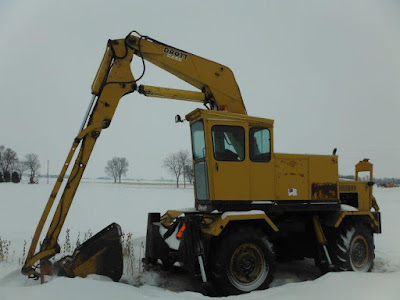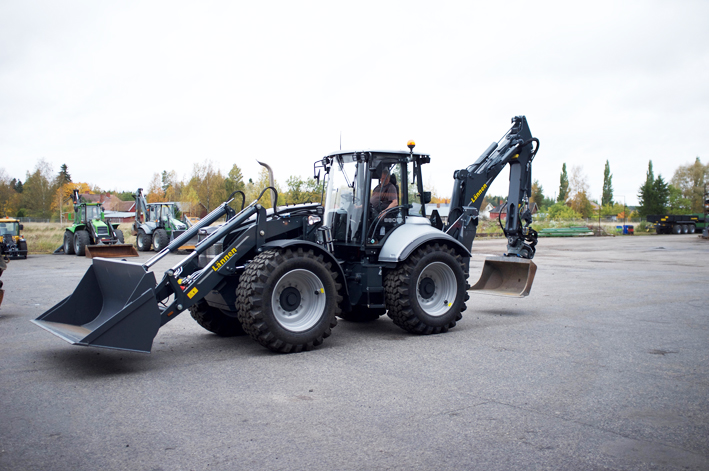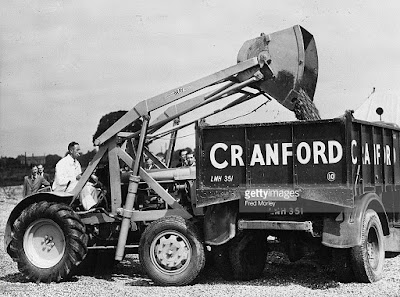Drott was the sole supplier of loader attachments for International Harvester crawler tractors in the 1950s, until International introduced their own line of integral loaders.
Edward Drott founded Drott Tractor Company in his home town of Butternut, Wisconsin, in 1916. It was moved to Wausau, Wisconsin, in 1923. In 1924, it was reorganized as Hi-Way Service Corporation and relocated again, this time to Milwaukee, Wisconsin.
In 1962, Drott purchased American rights to the Yumbo hydraulic backhoe produced by Sicam of France.
(Society de Industrial Construction of Mechanical Hydraulic Appliances = SICAM)
Shuttlelift, Inc. (collection 1369) acquired the Carrydeck line of industrial hydraulic cranes from Drott Manufacturing Company (Collection 376). Shuttlelift was acquired by Marine Travelift, who sold the Carrydeck line to The Manitowoc Company, Inc. (Collection 15) on January 5, 2007.
Model nomenclature:
Drott was the sole supplier of loader attachments for International Harvester crawler tractors in the 1950s, until International introduced their own line of integral loaders.
It developed the first multi-purpose bucket; dubbed the 4-in-1 bucket, it gets its name from its four functions: Dozer, clamshell, bucket and scraper.
The 4-in-1-line became the basis for International Harvester's crawler loader line.
Drott model numbers had a prefix that matched the model number for the tractor; i.e., the TD6 used a 6K3 loader. An “A” suffix indicated a later improved version.
Sources: Marathon Country History.
Drott oli ainoa kansainvälisten Harvester-telaketjutraktoreiden kuormauslaitteiden toimittaja 1950-luvulla, kunnes International esitteli omat kiinteästi asennetut kuormaaja sarjansa.
Edward Drott perusti Drott Tractor Companyn vuonna 1916 Butternutin kotikaupungissaan Wisconsinissa. Se siirrettiin Wausau, Wisconsin, vuonna 1923. Vuonna 1924 rakennettiin uudelleen Hi-Way Service Corporationiksi ja siirrettiin uudelleen, tällä kertaa Milwaukee, Wisconsinissa.
Hi-Way Service suunnitteli lumiauran yhteisyritykseksi Wausau Iron Worksin kanssa. Hi-Way Serviceista tuli Drott Manufacturing Company ja palasi Wausauen.
Vuonna 1962 Drott osti Amerikan oikeudet Ranskalaisen Sicamin tuottamalle Yumbo-hydrauli kaivureiden sarjalle.
Vuonna 1968 Tenneco osti Drottin ja liitti sen Case Corporation (Collection 227) divisioonaan, jonka myös omisti.
 Shuttlelift, Inc. (kokoelma 1369) hankki Carrydeckin teollisuushydraulinostureiden linjan Drott Manufacturing Companyn (Collection 376). Shuttlelift osti Marine Travelift, joka myi Carrydeck-linjan The Manitowoc Company, Inc: lle (Collection 15) 5. tammikuuta 2007.
Shuttlelift, Inc. (kokoelma 1369) hankki Carrydeckin teollisuushydraulinostureiden linjan Drott Manufacturing Companyn (Collection 376). Shuttlelift osti Marine Travelift, joka myi Carrydeck-linjan The Manitowoc Company, Inc: lle (Collection 15) 5. tammikuuta 2007.Mallinimikkeistö:
Drott oli ainoa kansainvälisten Harvester-telaketjutraktoreiden kuormauslaitteiden toimittaja 1950-luvulla, kunnes IH esitteli omat kiinteästi asennetut kuormaajat.
Se kehitti ensimmäisen nelitoimi-kauhan jota kutsutaan 4-in-1 kauha, se saa nimensä sen neljästä käyttömahdollisuus toiminnosta puskuri, simpukka, kauha ja kaavin.
4-in-1-linjasta tuli IH, eli International Harvesterin tela-kuormaajien sarja.
Drottin malli-numeroilla oli etuliite, joka vastasi maatalous-traktorin mallinumeroa ts. TD6 käytti 6K3 kuormaajaa. "A" -pääte osoitti myöhemmin parannettua versiota.
Lähteet: Marathon Country History.




















































